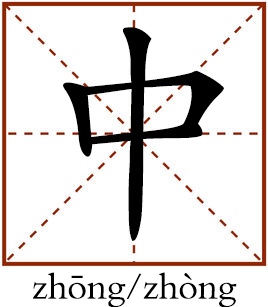Center

When pronounced as zhōng, this character is often used as a noun or an adjective, referring to the center or middle. When pronounced as zhòng, this character is usually used as a verb with a meaning of “attain” or “hit [the target].”
逐鹿中原
zhú lù zhōng yuán
Zhu means “chase” and lu refers to a stag. Zhong yuan refers to the Central Plain, the area on the lower reaches of the Yellow River that formed the cradle of Chinese civilization, which is also traditionally valued as the heart of China. This idiom, taken literally, means to chase a stag on the Central Plain. It indicates a fight for the throne.
This idiom originated from the Shi Ji (Records of the Historian), written by Sima Qian. At the end of a story, Han Xin (c. 231–196 BCE), a famous military general who served Liu Bang (the founder of the Han Dynasty) and who contributed greatly to the founding of the Han Dynasty, was accused of participating in a rebellion and lured into a trap and executed on Empress Lü Zhi’s order. A political advisor named Kuai Tong had proposed to Han Xin to make Han independent of Liu Bang so Han could proclaim himself a king. For this, even though Han had refused, Liu Bang wanted to arrest Kuai, but Kuai argued, “Qin (the Qin Dynasty) lost its stag—the imperial power—and all the world has been chasing after it....Many men have sharpened their weapons and took up arms, eager to do as you did. But their strength was not equal to yours. Do you intend to throw them all into the cauldron?” Finally, Liu let Kuai go.
The stag has traditionally been a symbol of imperial power in China. Why this animal is associated with power is still uncertain. It is generally believed that stags, or deer, harmless animals with little resistance to predators, originally represented the common people of a country, who were the prey of various forces. During the reign of Qin Shi Huang, the emperor used harsh methods to control the country. Those harsh methods, combined with the huge tax levies needed to pay for construction projects and wars, took their toll. After Qin Shi Huang’s death, rebellion erupted and Qin’s rule was weakened. Various clans raised armies and fought for the throne. That was why Kuai Tong used the metaphor of the stag to describe the situation at the time.
edited by REN GUANHONG
